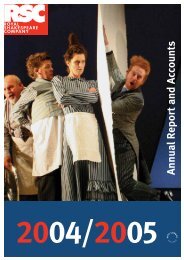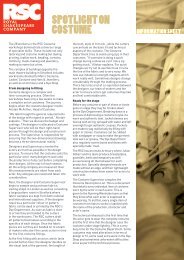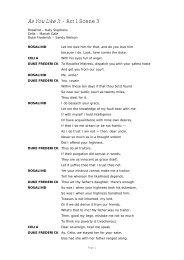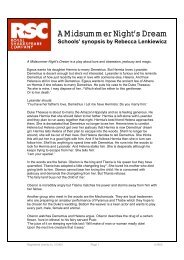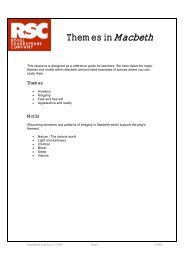THE TAMING SHREW - Royal Shakespeare Company
THE TAMING SHREW - Royal Shakespeare Company
THE TAMING SHREW - Royal Shakespeare Company
Create successful ePaper yourself
Turn your PDF publications into a flip-book with our unique Google optimized e-Paper software.
INTRODUCTORY NOTES<br />
In 1928 Sir Arthur Quiller-Couch wrote in his Introduction to the New Cambridge edition of<br />
The Taming of the Shrew:<br />
‘Let us put it that to any modern civilised man, reading . . . the Shrew in his library,<br />
the whole Petruchio business. . . may seem . . . tiresome - and to any modern<br />
woman, not an antiquary, offensive as well.’<br />
What was <strong>Shakespeare</strong> up to in this early play and how can it say something pertinent to us<br />
in our own time? What can explain Katherine’s transformation from social rebel to<br />
compliant wife? Was <strong>Shakespeare</strong>, creator of Portia and Rosalind, here in this play an<br />
advocate of Elizabethan mercantile marriage and shrew-taming? Or was he describing<br />
contemporary attitudes and practices for the reflection and possibly reformation of his<br />
audiences? Whatever the answer to that question, what insight can this raucous battle of<br />
the sexes in which the woman loses, give us into the nature and conduct of our own<br />
relationships?<br />
In recent years theatre directors have staged a variety of<br />
answers to that question, ranging from a grim comment on<br />
the continuing repression of women in our own society to<br />
the idea that both Kate and Petruchio find comfort and<br />
peace in mutually-accepted boundaries.<br />
Several contemporary productions have presented Kate and<br />
Petruchio as outsiders who are genuinely attracted to one<br />
another and eventually forge a trusting relationship which<br />
heals old wounds. The production directed by Lucy Bailey<br />
adds to this perspective a very strong sexual attraction - an enormous bed is the central<br />
feature of the set design. Crucially, these two social outcasts find in their relationship the<br />
confidence to mock and reject the commercial, conformist values of the society that has<br />
mistreated them in the first place.<br />
ORIGINAL PERFORMANCE CONDITIONS<br />
The Taming of the Shrew was written some time between 1592 and 1594. It was likely that it<br />
was first performed at the Newington Butts Theatre, now under the southern roundabout of<br />
the Elephant and Castle junction in London. Newington Butts was one of the earliest of<br />
Elizabethan theatres, possibly the first dedicated Elizabethan playhouse.<br />
<strong>Shakespeare</strong> may have written The Taming of the Shrew for the Earl of Pembroke’s men, one<br />
of the professional theatre companies of the time.<br />
<br />
For more about Elizabethan staging practices, read ‘<strong>Shakespeare</strong>’s theatre’ at:<br />
www.rsc.org.uk/education/resources/social-historical-context<br />
For more about the performance history of Shrew:<br />
www.rsc.org.uk/explore/taming-of-the-shrew/performance-history<br />
Registered charity no. 212481 © <strong>Royal</strong> <strong>Shakespeare</strong> <strong>Company</strong> Page 2



